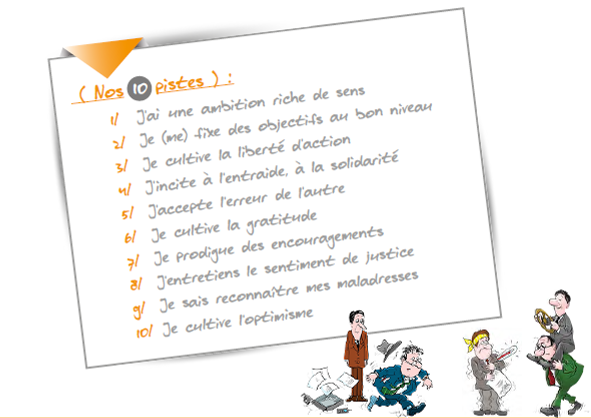The transformation of CPAM Yvelines, initiated in 2012, is taking shape. Employees have gained autonomy through the implementation of adapted Lean management in certain teams, and their ideas come to life through their managers and the ID'Nov platform. The tools for unleashing energies are in place, but there is still a task to tackle: that of employee engagement and well-being at work.
In 2015, the management posted an idea on ID'Nov, the newly created collaborative innovation platform: to create a guide on managerial postures at CPAM. This was in response to a conference on workplace stress and the desire to initiate a move towards "Kind and Demanding Management". It was a way for CPAM to find its own balance, three years after the start of the transformation. A group of employees who responded favorably to the call (still based on voluntarism) gathered to establish the 10 principles of CPAM's management, which must strike a balance between benevolence and demand.
Sans exigence, il n’y a pas de fierté. - Patrick Negaret
After numerous workshops, a group met for 2 days to finalize a list of 10 Quality of Work Life (QWL) principles:

These principles were not just displayed on a few walls in the offices. No, the employees endorsed them in a comprehensive and playful guide to quality of work life, dissecting the mechanisms of workplace stress.
To ensure that these principles have very concrete applications in the company's daily life, they needed to be translated into projects. Ten initiatives were conceived and directly taken on by employees of all levels and professions. The idea is always the same, and this fourth stage of the transformation is no exception: they want tangible results visible quickly. Groups were formed after these initial 2 days of workshops and were given carte blanche to determine the next actions, with leaders designated by their peers.
Numerous projects emerged, including:
- "Experience My Job": Discovery days of another activity to increase skills in other organization roles and strengthen the sense of belonging. Any employee can spend a day per year in the department of their choice.
- "Purchasing Choices": Employees were involved in committees, especially in choosing providers for collective catering or cleaning services. This group also drastically reduced expenses, going beyond what the management could have done, thanks to a platform for sharing and reallocating small equipment.
- "Thank You, Colleague" gift voucher: To cultivate gratitude, a group proposed exchanging €15 gift vouchers (paid by the company) on the intranet. Of course, no validation from the hierarchy is required; it's a voluntary donation.
Once these practices were implemented, it was necessary to ensure that they met expectations. A voluntary group worked on the subject to develop a work-life quality barometer. Wanting a representative questionnaire, they focused on 8 questions that cover the 8 evaluated criteria: autonomy, the quality of the relationship with hierarchy, workplace atmosphere, motivation, job satisfaction, recognition from hierarchy, equity at work, and the relevance of work organization.
I don't want this company to be run by procedures, but by people who know why they do what they do. - Patrick Negaret
To maximize participation, the questionnaire was printed and distributed in the services. 97% of people responded to the survey, which is enormous compared to the 35% response rate for the annual institutional barometer of Ucanss (Union des Caisses Nationales de Sécurité Sociale)!
Once all the results were collected, they were communicated to all employees, and each service manager had to present the results specific to their teams. While the exercise was not easy for everyone, it allowed for open communication and an assessment. In one service, the overall results of the barometer were positive, but one criterion was lacking: equity. The manager then gathered all the employees for the announcement of the results, and she formed six groups of about ten people to delve into the responses. Several discussions revealed that career advancement and schedule management were the causes. As the schedules were variable in this team with fixed hours, finding a balance in rotations was not always easy, and some employees noticed injustices. A better rotation was then found during this workshop, and a skills table was designed to better determine who is eligible for variable hours.
Some stories sometimes better illustrate the journey taken and the strong culture of mutual aid that infused during this transformation. For example, the versatile service in benefits regularly assists other services by taking over their files. Thus, 5,000 files from the beneficiary management service were processed by this service in 2017, and 7,000 in 2018. It also took charge of regularizing files processed by the work accident service: this saved 3 FTEs between July and September 2017!
And you, can you imagine this in your company?




